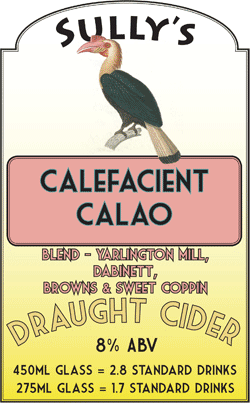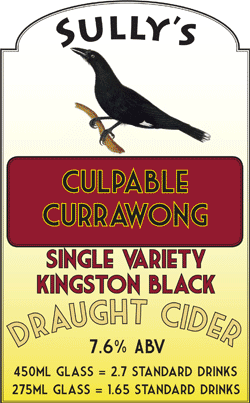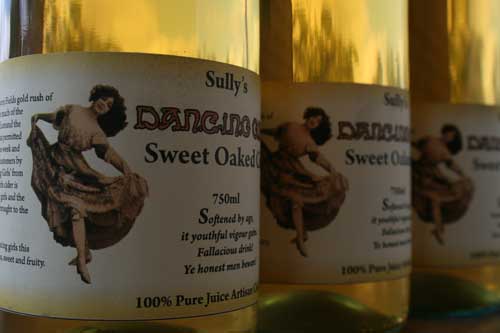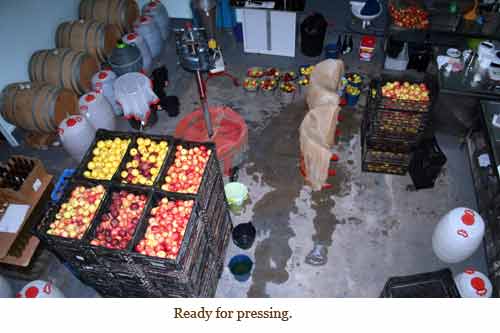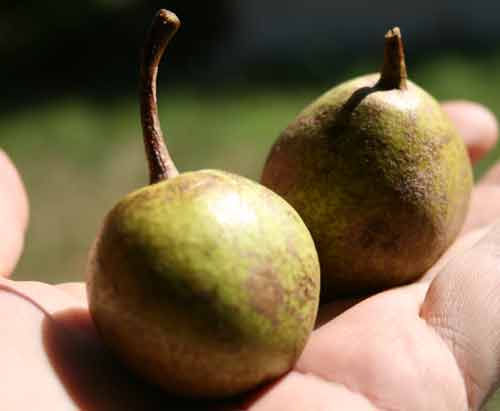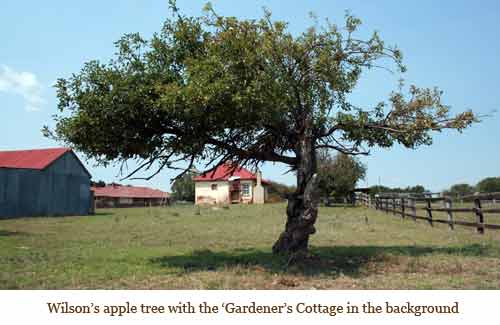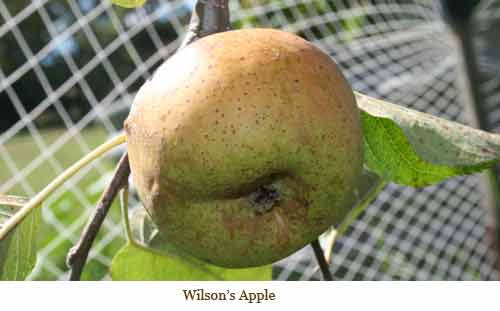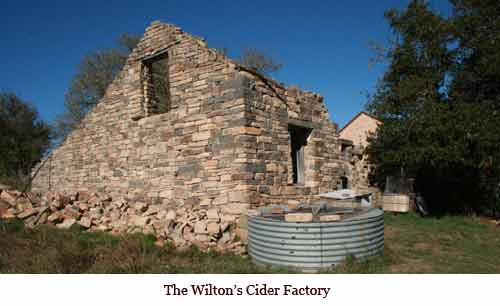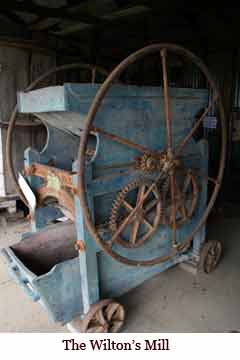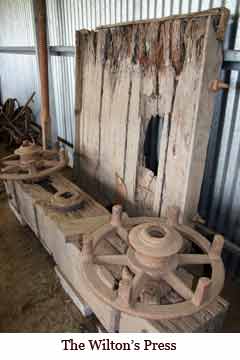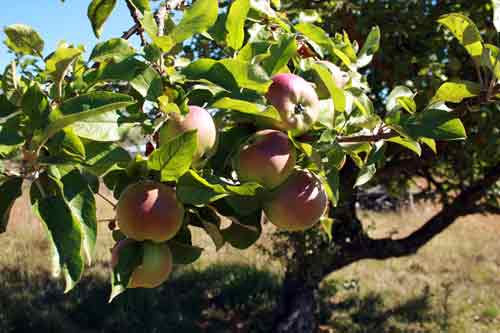

Enquiries
(02) 4846 1999
0407 292 181
info@braidwoodmade.com.au
| Sully's Cider & Wine |
|
||
Cider At Sully’s cider we produce a range of varietal and blended ciders. Our ciders are crafted using traditional techniques and styles. We use 100% juice, making our finished cider between 6% and 9% ABV, depending on the natural sugar content of the juice. The apples that we use are genuine cider apples, local heritage cider apples, and local feral seedlings that have been especially selected for their cider qualities. Our ciders are sold almost exclusively from our cellar door at The Old Cheese Factory and at the Braidwood farmers' market.
Cider Making The craft cider making process starts with the apples. Although cider can be made from the juice of any apple and, with a little tinkering, a drinkable beverage can be obtained using most varieties, it is the use of dedicated cider varieties that makes high quality craft cider as produced in the traditional cider making regions of the West of Britain, Normandy and Brittany in France, and the Northern parts of Spain.
Cider apples are roughly catergorised into four categories; sharp, bittersharp, bittersweet and sweet. The sharps and the sweets can be substituted for cooking and dessert apples respectively. The bittersweets and bittersharps are important as they provide tannins and varying levels of acid, needed to balance the cider. As well as providing a means to balance the sugar, acid and tannin in a cider, dedicated cider varieties also bring an array of distinct flavours to the mix. Once we have chosen our blend of apples they are stored in crates for up to three weeks to concentrate the juice. Next they are washed and run through a mill. The resulting pulp is layered in cloth and pressed in our hydraulic basket press. The juice is then stored in fermenting tanks.
Early in the season, when temperatures are still warm we allow the juice to ferment naturally. During the colder months we inoculate with cultivated yeast. Again, depending on temperature the initial fermentation can last from 3 to 8 months. We monitor the juice throughout the fermentation and rack (remove the juice from the sediment) accordingly. If we want a crisp acidic style cider we finish the ferment in stainless steel tanks and bottle before malolactic fermentation can occur. If we want a less acidic and mellow cider we rack the cider into oak barrels and waite for the malo' to happen around September. The ciders are then either bottled still, conditioned in the bottle to create an effervescence or processed using méthode traditionnelle to create a champagne styled cider. Perry There are only four known Perry (The pear equivalent to Cider) Pear varieties in Australia. Yet, when we arrived in Reidsdale we noticed a number of very large old pear trees with fruit that looked suspiciously like perry varieties. Tell tale signs were small hard fruit with a propensity to rot from the inside out and they were seemingly unpalatable due to high levels of tannins. We have propagated a number of these trees for future perry making and we have on occasions made perry from the fruit off the old trees.
Wines Our family has been producing country wines for generations. All of our wines are hand made using recipes based on traditional methods and are are made from locally grown and foraged produce. We have delved into many historical records to revive many flavours and wine making techniques of the past. Some of our wines are very rare and unusual, such as green walnut and stinging nettle, and are available seasonal small batches.
Some of the wines that we have we produced include Elderflower, Elderberry, Peach, Nettle, Cherry, Dandelion, Blackberry, Borage, Hawthorn Blossom, Rhubarb, and Apple... to name a few. |
Local Cider Heritage The heritage of cider making in the Braidwood district is much unheralded and rivals that of many of the traditional cider making regions of Britain and France. Many of the early settlers to the district were ex-surgeons on convict ships at a time when the Royal Navy was experimenting with cider as a prophylactic to prevent scurvy. As such they would have been aware of the benefits of cider and may will have had knowledge of cider making. Arriving in a district of cold winters bereft of green food, it seems logical that they would have planted cider apple trees and made cider to preserve the goodness of the fruit through the winter months. Evidence suggests that they did! A small remnant apple tree stands just clinging to life on the estate of Dr Thomas Braidwood Wilson. It is within a stones throw of the gardeners cottage and was probably planted in the late 1830s by his gardener Farquhar Aberdeen. We believe the variety to be a Golden Pippin as described by Robert Hogg in The Fruit Manual 1860.
"Fruit, small, two inches wide, and about the same in height;
There is much confusion around the Golden Pippin as the name has been attached to many distinct varieties. We believe the Wilson apple to be the version used for eating and for a high quality distinctive cider in the style of the eastern counties of England. Another naval surgeon to settle in the Braidwood district was Doctor Thomas Bell. It seems that Dr Bell was well acquainted with cider. "The first owner of Bell's Paddock and Creek goldfield was Dr.Bell an army surgeon, who also purchased an estate on the Shoalhaven, where he had a large orchard of English fruit trees and manufactured immense quantities of cider and perry." Bell purchased the land on the shoalhaven in 1840 and died 14 years later. Charles and Hannah Wilton ventured to nearby Majors Creek sometime in the mid 1800s and by the late 1880s they had established a cider factory that echoed the traditions of their native Somerset. The old stone built factory remains, as do a few apple trees from the original orchard. With a little investigation we discovered other farms also grew apples for the cider factory, some of these orchards survive today.
Our ultimate goal is to produce a cider using the apples, techniques, methods, and equipment as used by the Wiltons, to recreate an authentic heritage cider experience. With a small planting of the Wilton apples already producing we are making cider that contains juice from the Wilton apples and with subsequent plantings coming on, we are well on way to reaching our goal. In reviving the local craft cider and perry industry we hope to encourage local land owners to value old fruit trees and to care for them. This in turn will help to conserve the local landscape, wildlife and cultural heritage.
|
||
© Sully Consultants Pty Ltd
The Old Cheese Factory, 92 Sawyers Ridge Road, Reidsdale, NSW 2622.

